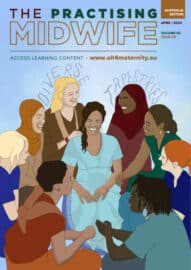Upright and Active Birth – Active Support!
Molly O’Brien – Midwife and midwife educator, Optimal Birth
Instagram @biomechanics_for_birth
Published in The Practising Midwife Volume 25 Issue 02 February 2022 https://doi.org/10.55975/OIGH7546
Introduction
Birth is a dynamic process – the urge to move is both intuitive and instinctive. It also works wonders with physiology. Midwives should understand how physiology is optimised and how to provide support that maximises the opportunity for positive, healthy outcomes.
The benefits of movement
Moving provides some relief from the intensity and power of contractions, more satisfaction and a feeling of control.1 Freedom to move allows the possibility for the labouring woman to listen to her body, taking up positions that allow expansion, creating more space. The mother-baby dyad work together in synergy, an exquisite partnership.
Most people have a need to move. Upright at first then often, women lower themselves towards the floor as birth advances, bringing herself to her knees as the pelvis, a magnificent articulated architectural structure, shifts its purpose to become a portal for a tiny human to enter the world.
Active labour and upright birth positions are most often witnessed in environments where the mother is free to move.2 All-fours position and kneeling are favoured as the sacrum can move freely.3 Birth is more straightforward because physiology is optimised.
When the woman has freedom to mobilise and to choose her own birth position, less intervention is required – instrumental birth rates, caesarean births, episiotomies and severe perineal trauma are all reduced.3 ‘A room that promotes activity inspires the mother to movement.’2
The majority of births take place in hospitals where most women and birthing people are in a semi-recumbent and supine position, and 24% of unassisted vaginal births are in lithotomy.4 These birth rooms are designed for passivity made obvious by the dominance of the bed.2
Inspiring movement
How can midwives inspire a mother to move in a birth room that’s not designed for active birth? Rearranging the room will have an immediate effect. Push the bed aside, raise it up high so it can be used to lean on. Bring mats, peanut balls and birth balls into the birth space to encourage active birth. Other equipment such as ropes from the ceiling can help.
Using a birth ball helps to cope with the intensity of contractions.5 Peanut balls are useful if movement is restricted. Pelvic diameters are increased and the length of labour and instrumental and caesarean births are decreased.6
While midwives should make every effort to create an environment that encourages activity rather than passivity, they should not be prescriptive in encouraging specific positions.7 The optimal birth position is one chosen instinctively, whether upright or supine: everyone has the right to move in a way that fits best for their baby passing through their particular pelvis. TPM
For more information on support for active births, visit Croyde Medical
References
- Priddis H, Dahlen H, Schmied V. What are the facilitators, inhibitors, and implications of birth positioning? A review of the literature. Women Birth. 2012;25(3):100-106. doi:10.1016/j.wombi.2011.05.001.
- Andrén A, Begley C, Dahlberg H, Berg M. The birthing room and its influence on the promotion of a normal physiological childbirth – a qualitative interview study with midwives in Sweden. Int J Qual Stud Health Well-being. 2021;16(1):1939937. doi:10.1080/17482631.2021.1939937.
- Zang Y, Lu H, Zhao Y, Huang J, Ren L, Li X. Effects of flexible sacrum positions during the second stage of labour on maternal and neonatal outcomes: A systematic review and meta-analysis. J Clin Nurs. 2020;29:3154-3169. doi:10.1111/jocn.15376.
- Care Quality Commission. NHS Patient Survey Programme. 2019 survey of women’s experiences of maternity care: Statistical release. https://www.cqc.org.uk/sites/default/files/20200128_mat19_statisticalrelease.pdf. Published January 2020. Accessed November 25, 2021.
- Grenvik JM, Rosenthal E, Wey S, et al. Birthing ball for reducing labor pain: a systematic review and meta-analysis of randomized controlled trials [published online ahead of print, 2021 Jan 21]. J Matern Fetal Neonatal Med. 2021;1-10. doi:10.1080/14767058.2021.1875439.
- Tussey CM, Botsios E, Gerkin RD, Kelly LA, Gamez J, Mensik J. Reducing Length of Labor and Cesarean Surgery Rate Using a Peanut Ball for Women Laboring With an Epidural. J Perinat Educ. 2015;24(1):16-24. doi:10.1891/1058-1243.24.1.16.
- The Royal College of Midwives. RCM Midwifery Blue Top Guidance No.1 Nov 2018: Midwifery care in labour guidance for all women in all settings. https://www.rcm.org.uk/media/2539/professionals-blue-top-guidance.pdf. Published November 2018. Accessed November 25, 2021.







